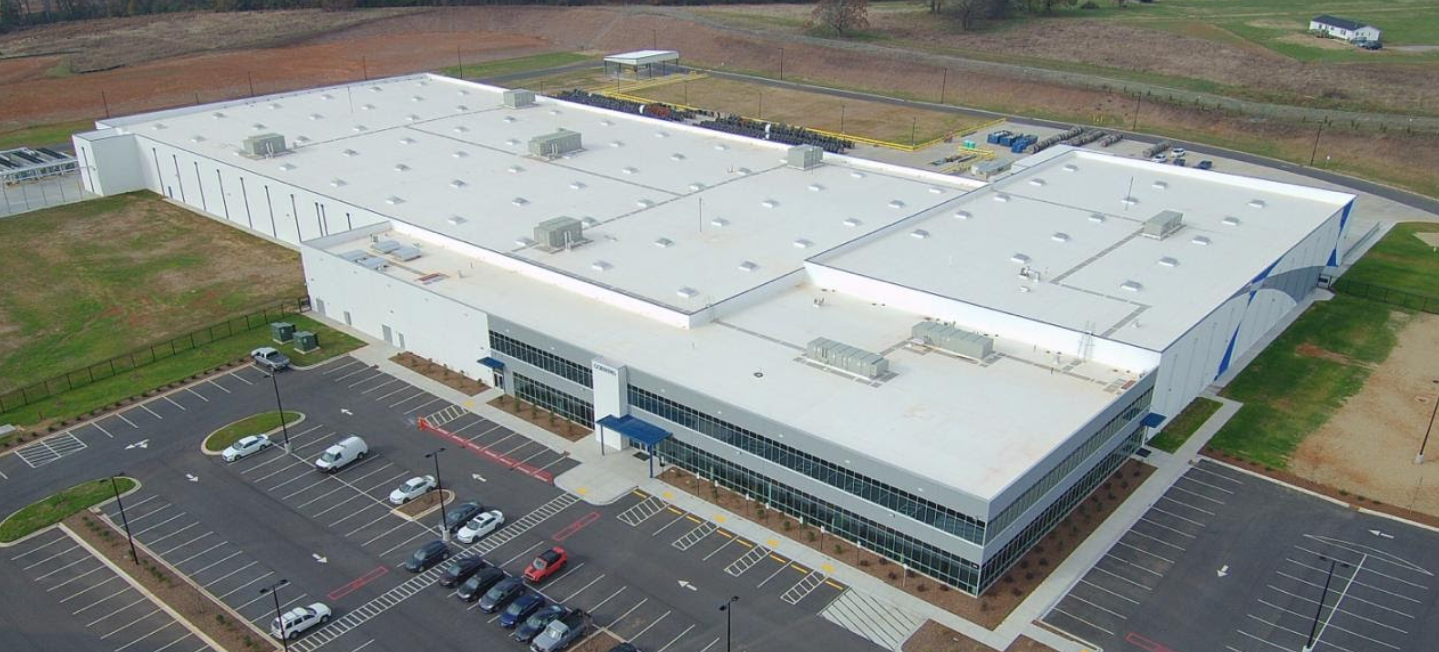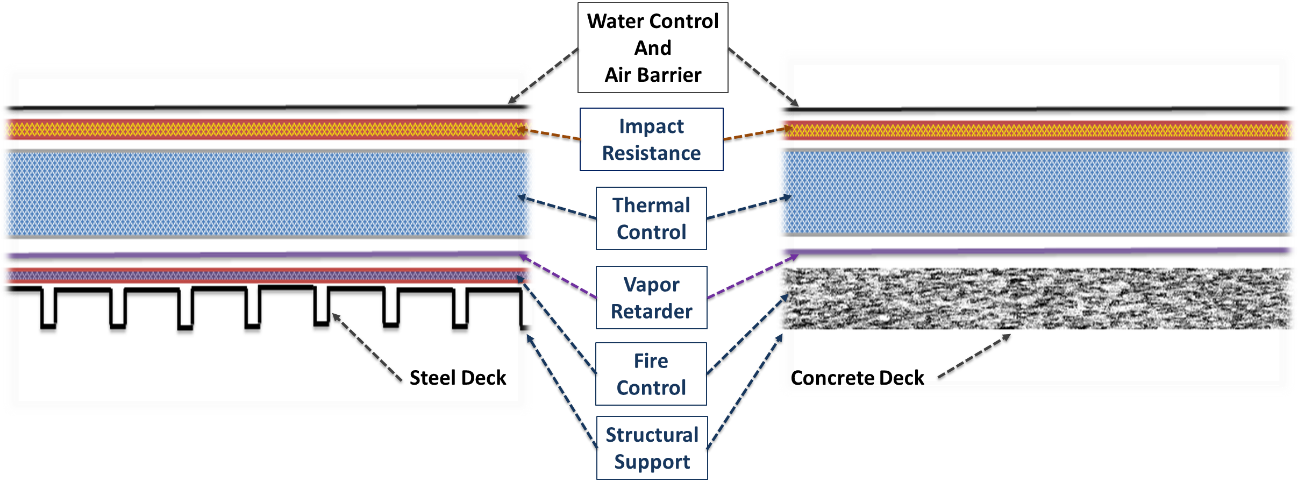Low-Slope Roofing—Air Barriers and Vapor Retarders
Learning Objectives:
- Distinguish between the various control layers within roof assemblies, with particular attention to the control of air and moisture.
- Describe the reasons why air barriers and vapor retarders can be necessary and under what circumstances they are required.
- Identify which materials are appropriate for use.
- Recognize the pros and cons of the various choices that can be made for air barrier and vapor retarder placement within roof assemblies.
Credits:

All images courtesy of GAF, except as noted
If we traveled back in time to the first dwellings humans constructed after they left natural shelters, we’d find that the role of the roof was to keep rain and other precipitation out. Caves and cliff overhangs were good at that, shelters made from vegetation such as grass and straw less so. Fast forward to the industrial revolution and you’ll notice that roofs became very good at controlling water ingress. At that time, shelters had evolved into dwellings and homes and a new type of building emerged—the workplace, whether factory, office or warehouse.
As buildings have evolved, so have the requirements that have been placed on the building enclosure. No longer “just” a roof to keep precipitation out, today’s enclosure has many roles. Those roles are often carried out by different layers in the enclosure assemblies, whether they are roof, wall, or foundation. To help understand vapor retarders and air barriers, it helps to briefly review each layer’s role, beginning with the obvious and oldest before moving on to the recent air and vapor control roles.
- Water control—this is the obvious function of the building enclosure. Less obvious is the fact that for the wall of an enclosure, a 100 percent successful water barrier is considered to be unlikely. Hence the word “control.” Walls, with their many penetrations, plus doors and windows, are difficult to make entirely “waterproof.” Good wall designs accept the fact that some water ingress might occur and they have features that allow that water to drain down and then out of the structure.
- Structural control—every building enclosure assembly has structural elements, each supporting the others. In the case of a low-slope roof, the structural control is frequently supplied by the roof deck and any sub-structure beneath it. Structural support is not absolute and depends on snow loads, wind uplift pressures, expansion/contraction etc; hence the word “control.” As we’ll see, each layer of a roof assembly provides control over a property and is rarely absolute.
- Thermal control—going back to our description of the first dwellings, while preventing water ingress was a primary function of the first building enclosures, keeping occupants from freezing became an additional function. Today’s low-slope roof assemblies typically use an insulating foam such as polyiso. Good design is important so that the effects of thermal bridging and penetrations are taken into account.
- Air barrier—air leakage has been identified as a major impediment to achieving better energy efficiency of the building enclosure. Essentially, the goal is to prevent the loss of conditioned air from the interior to the exterior and the introduction of warm, humid air from the exterior to the interior. Just as thermal control needs to take into account thermal bridging and penetrations, so a material that blocks air is insufficient in and of itself. An air barrier, as we’ll see later, is an interconnected series of materials spanning the entire enclosure.
- Vapor retarder—for a variety of reasons, including the increasing air tightness of buildings and the use of air conditioning, it is ever more important to control moisture ingress into wall and roof assemblies. Importantly, control of moisture ingress from air leakage at assembly joints and vapor diffusion through materials can be achieved either through the use of layer material specifically designed for the purpose, or through careful installation of, for example, the thermal or air barrier control layer. All materials in a roof or wall assembly have some vapor retarding properties and the choice to include a specific vapor control layer should be considered along with the local climate, the building use, and the degree of assurance that vapor movement is retarded sufficiently.
- Other control layers—in some specific cases, other control layers can be added depending on requirements. For example, a cover board could be present to improve impact resistance. A cementitious or gypsum board might be added to improve fire ratings.
The Hypothetical “Complete Roof Assembly”
The hypothetical complete roof assembly is a conceptual design that shows each of the possible control layers described above and arranges them in an order that could be used as a starting point for many designs. In practice, not all will be needed and the order might change depending on material selection. Importantly, it assumes that each control layer is separate, which is not necessarily the case. The following schematic shows two possible such roof assemblies, one based on a steel deck and the other on a concrete deck.

The hypothetical complete roof assembly schematic shouldn’t be used as an absolute design, but is a guide as to which control layers might be used. As stated earlier, some control layers might not be necessary and some might be combined. The important point is that it is useful to think about each possible control layer and then make decisions about which are needed, which can be combined, and so on. Also, the order of layers can be different, depending on building use, local climate, and other factors.
The schematic only shows the various layers within the field of the roof. However, very importantly, the order and sequencing of layers is strongly influenced by the edges. This means that how the roof is tied into or connected with the wall and its various control layers has a large influence on the order of the layers and which controls might be carried out by one layer. This is particularly the case when discussing air barriers and vapor retarders.
While the water and thermal control layers, i.e. the roof membrane and thermal insulation, are well understood, the use of air barriers and vapor retarders is still a source of confusion.
The use of air barriers and vapor retarders in construction is increasing rapidly, but many people from building designers through specifiers to installers remain confused as to the differences between them. There are many questions that frequently arise, such as:
- What is the difference between an air barrier and a vapor retarder?
- Is a vapor retarder the same thing as an air barrier?
- What have these materials got to do with roofing?
One problem with the entire topic is that there have been other terms used such as vapor barrier, air resistance layer, and moisture control layer. Are these related or different materials? Also, there can be confusion about what the roof designer or even the code requiring these materials is attempting to achieve or remedy.
Let’s begin with terminology; leading experts and trade associations such as the Air Barrier Association of America (ABAA) suggest using just these two terms: Air Barriers and Vapor Retarders. Each of those might have some variations that we’ll discuss later, but forget all the other terms and just use these two. It makes sense to start with air barriers and review why they are needed and where they can be placed.
Air Barriers
Why Are They Used?
It’s all about improving a building’s energy efficiency. Adding more insulation to a building enclosure has reached the point of rapidly diminishing returns. Also, insulation thicknesses are such that further increases would be difficult to accommodate without large increases in cost related to wall thickness or when reroofing for example. Air leakage has been identified as a significant impediment to further improvements in building energy efficiency. A building owner is paying to heat or cool the interior air, why allow significant loss of that conditioned air to the outside?
In 2012, the International Energy Conservation Code (IECC) published air barrier requirements, stating that “Continuous air barrier shall be provided throughout the building envelope with the exception of climate zones 1, 2 and 3.” The purpose of an air barrier is straightforward:
- Minimize the loss of conditioned air from within a building.
- Reduce energy loss—increase building energy efficiency.
So, what does this mean for the commercial low slope roof? Most people would assume that low slope roof membranes are automatically air barriers. However, that’s not the case and it’s very important to note that:
- The air barrier is a system of materials that controls air leakage/convective heat flow through the building enclosure from the interior to the exterior.
- The air barrier is not one material but instead is an integrated system of many different materials/components.
In the hypothetical complete roof assembly shown earlier, it would appear that the membrane is automatically going to be the air barrier. However, as noted, to be successful it must be tied into the material designated as the wall air barrier in such a way as to ensure there are no air leaks at the junction. Consider how a roof membrane often runs up and over a parapet wall. The building designer needs to specify that the membrane not just overlap the wall air barrier, but be flashed or sealed to it so that air cannot escape.










